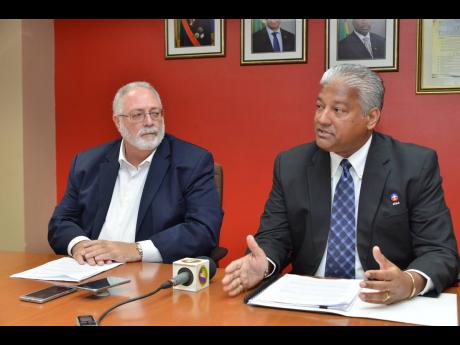JCAA defends plane approval process
There is renewed scrutiny of the Jamaica Civil Aviation Authority (JCAA) following a new revelation that eight months before a flight-school plane crashed in Kingston, it had granted approval for the aircraft to operate here.
On March 9, 2016, the plane was approved by the JCCA to join the fleet of the Caribbean Aviation Training Centre based on Marcus Garvey Drive in St Andrew; that’s just over two years after a reported engine overhaul.
However, seconds after take-off from the Tinson Pen Aerodrome on November 10, 2016, the Cessna aircraft went down in the inner-city community of Greenwich Town, bursting into flames on impact and killing flight instructor Jonathan Worton, 56, and student pilots Danshuvar Gilmore, 19, and Ramone Forbes, 17.
According to the findings of the crash investigation report made public by The Gleaner two months ago, the United States (US) firm listed as the maintenance operator denied ever working on the engine of the Cessna aircraft.
In fact, the report, authored by government-appointed lead investigator Richard Jones and sanctioned by the US Transportation and Safety Board, said One Stop Aviation told investigators that any work order produced for the engine of the crashed airplane would have been forged.
SUFFICIENT CHECKS
The development raises questions as to whether the JCCA had undertaken sufficient checks before it decided to approve the Cessna airplane registered N101KA to fly in Jamaica.
“It is incumbent, there has to be that level of trust,” Director General of the Civil Aviation Authority Nari Williams-Singh told The Gleaner in an interview from his Winchester Road offices in Half-Way Tree, St Andrew.
So what happened when the JCAA received the application for the Cessna airplane registered N101KA to join the fleet of the flight school?
Williams-Singh said the approval process comprised reviewing all the required documents submitted by the flight operator, checking to ensure that they bore the names of approved aviation service providers and undertaking a physical inspection of the plane.
“In this aviation industry, where safety is paramount, there is that reliance on an operator, as well that their operating principles should be that due diligence is done on their part and the documentation that they are providing is genuine,” said Williams-Singh.
He maintained that ultimate responsibility lies with the aircraft operator as the JCCA is concerned about oversight and regulation of the aviation industry.
He also said there would be no way to pull down the engine and check if there were deficiencies as identified in the crash probe.
Williams-Singh was supported by the JCAA chairman, Phillip Henriques.
“Unless there is a red flag, there would not be a deeper due diligence,” Henriques said.
BOUND TO HAPPEN
Based on the crash report, the accident was bound to happen. It concluded that the internal timing of the engine was out by one tooth, which threw off the timing alignment on the starter ring gear by seven teeth.
The flight-school operator has, however, challenged that finding, saying the ring gear was left at the crash site and was never sent overseas for the detailed engine tear-down inspection.
“My ring gear was intact,” Captain Errol Stewart told The Gleaner in March.
Stewart also claimed that of the prescribed 50 hours of flying time before his engine was due to be serviced, there were 17 hours remaining, and so the engine had not been pulled since the plane was approved by the JCCA in March 2016 to join the flight school’s fleet.

